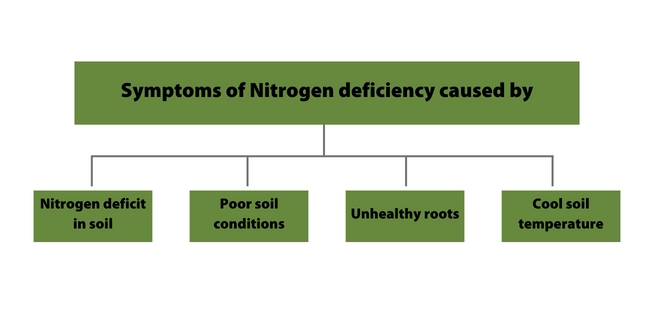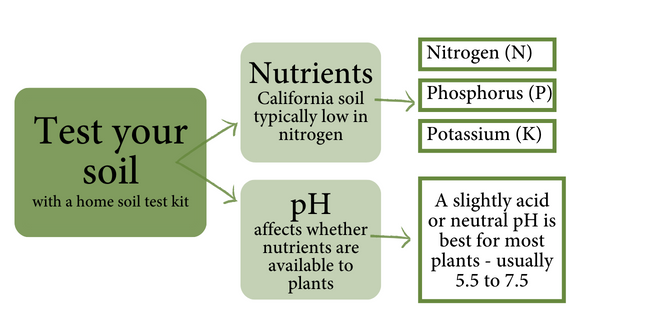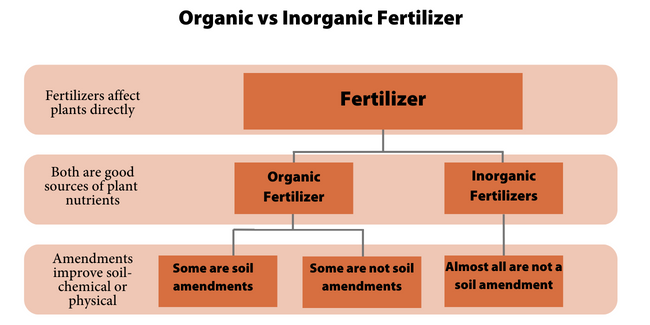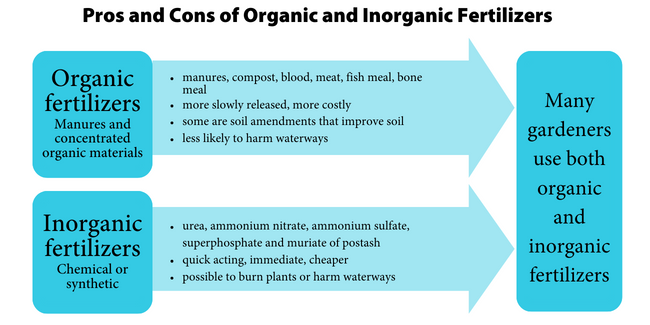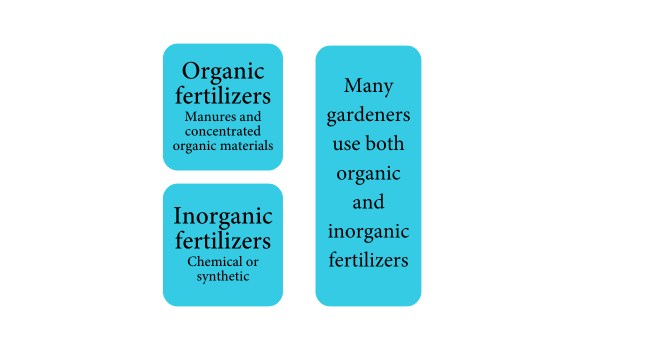Spring is here, and it is time to think about fertilizing citrus and fruit trees, berries, flowering ornamentals, and vegetables. Decisions need to be made about whether to fertilize, what to fertilize, how much to fertilize. The first article “Home Gardening Fertilizing Part 1: Fertilizers 101” in this series on Fertilizers and Fertilizing talked about what fertilizers are, what they are composed of and what different forms they come in.
This article, “Home Gardening Fertilizing Part 2: Spring is Here. Is It Time to Fertilize?”, the second of the three-part series on Fertilizers, is divided into two sections: (1) Analyze and Test; (2) Learn About and Then Select the Fertilizer Type(s) You Want to Use.
The question of fertilizing, how much and when is a complicated question. The decision of whether to fertilize should be based upon the health of the plant and the type of soil as well as what is happening growth-wise and with fruit and flower production. If you are satisfied with the growth, appearance, and health of your plants, you may not need to fertilize. Most of your landscape trees and shrubs do not need fertilizing to grow well. California natives do not need to be fertilized because they are adapted to California soils.
First Steps: Analyze and test
Take a look around your garden analyzing your plants, their appearance and size, and whether they produced what you hoped for.
Yellowing leaves has many causes and does not automatically mean that fertilizer is needed.
For instance, plants often show yellowing leaves in early spring when soils are too wet and/or too cold for their roots to absorb nutrients. In that case, applying nitrogen fertilizer will not fix the yellowing of the leaves.
Nitrogen deficiency symptoms include slow growth, yellowing leaves in older leaves, smaller than normal fruit, leaves and shoots.
Nitrogen deficiency may not be just because of a deficit in nitrogen in the soil. Nitrogen deficiency symptoms such as slow growth and yellowing leaves may be due to poor soil conditions, unhealthy roots or even cool soil temperatures.
Fruit trees, especially citrus, usually need fertilizing as do vegetable gardens and some flowering ornamentals.
Why should you care about overfertilization? It is important to know whether fertilization is needed or not and how much since too much fertilizer can cause problems for plants and the environment.
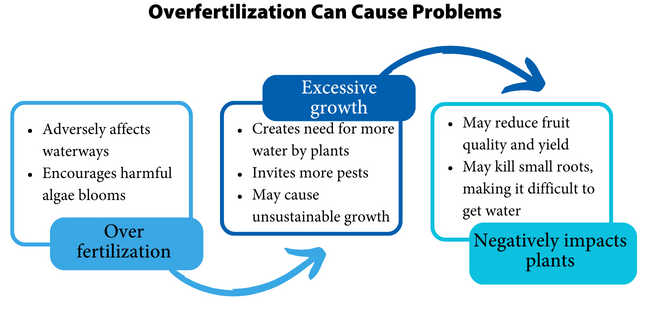
Overfertilization can lead to excessive growth which in turn leads to more pruning, increased need for water, and more pests. If you are unsure, using less is best.
Too much nitrogen can promote leafy green at the cost of reduced fruit production. Too much nitrogen and phosphorus can lead to “dead zones” causing fish kills and a decrease in aquatic life.
To avoid overfertilization, test your soil for nutrients and pH.
Testing for nutrients
To determine the amount of fertilization, first do some home testing of the soil for the three components of fertilizer: nitrogen (N), phosphorus (P), and potassium (K).
California soils are typically low on nitrogen whereas potassium is usually adequate. Although Alameda County has areas with sandy soil along the bay, especially in the island city of Alameda; much of Alameda County soil is clay. Clay soil typically holds more nutrients than sandy soil.
Test the soil for nutrients in spring and fall and adjust the amount/type of fertilizer to achieve an acceptable level.
Testing for pH
You might also consider a pH test since pH can affect whether nutrients are available to plants. Typically, most plants do best when the pH is slightly acidic to neutral (pH of 5.5 to 7.5). What is pH and why do we care? This article will tell you: https://anrcatalog.ucanr.edu/pdf/8488.pdf. If plants show deficiency symptoms, make sure that the pH is appropriate for the plants that you are cultivating. If the pH is right but you still have symptoms, then consideration of fertilizers based on soil tests is appropriate. Here is an excellent article by Jim Downer, UC farmer advisor, "My Soil is Crap, Part II" that explains what impacts soil health and practical information on improving soil health.
Home Soil Test Kits
Many retail gardening centers offer commercial soil test kits for testing for nitrogen, phosphorus, potassium and pH. When considering the accuracy of the tests, these kits can provide sufficient information with convenience and low cost, according to UC farm advisors Dr Ben Faber and Jim Downer.
There are pH test strips that are also available at your local nursery, which can give you a general idea of the pH in your soil. Here is an article that defines pH, pH testing and how to adjust soil pH. Be patient when trying to adjust pH, adding any amendments affecting pH in small amounts and testing pH again.
Second Steps: Learn about and select the right fertilizer types
Once you have soil test results, then comes the process of selecting the product that best fits your needs. There are so many choices and so many confusing terms. Fertilizer, soil amendment, what is the difference between them? Organic or inorganic fertilizers, what is the difference and how to best use them?
Fertilizers and soil amendments affect plant growth differently, and the definition is blurred when organic fertilizers are considered because they fall into both the fertilizer and the soil amendment categories.
Fertilizer or Soil Amendment? Or Both? The effect of a material on plant growth determines whether it is considered a fertilizer or soil amendment. Fertilizers affect plant growth directly by improving the supply of available nutrients in the soil. Soil amendments influence plant growth indirectly by improving the soil's physical properties or chemical properties. However, the difference between fertilizers and soil amendments is not so clear when evaluating natural or organic products.
Organics may also improve physical properties of soil, such as improving its structure and water-holding or drainage capacity. If they do, they are also considered to be soil amendments.
Fertilizer may be organic or inorganic, each with its own advantages and disadvantages. Plants respond equally well to organic or inorganic (chemical) forms of fertilizers. The general belief that organic materials are better sources of plant nutrients than inorganic forms is not correct. Often, organics might be chosen as a fertilizer for other reasons. For example, some organic fertilizers such as compost can also help with improving the physical characteristics of soils by increasing water drainage for clay soils or increasing water holding capacity for sandy soils.
Organic versus Inorganic Fertilizer as Source of Nutrients
Pros and Cons of Organic and Inorganic fertilizers
Organic fertilizers are usually derived from various manures or concentrated organic materials like blood meal, fish meal, and bone meal. Organics usually cost more than synthetics and vary widely in nutrient content. Organics generally are more slowly released than inorganic fertilizers. Fresh manures must be aged before use to allow time for decomposition and leaching of excess salts. Otherwise, the plants may be damaged. Manures may also contain weed seeds. Purchased manure products are pre-aged and ready to use. Since organics are slower to release, there is less likelihood of excess runoff and leaching of fertilizer.
Inorganic (synthetic, chemical) fertilizers are composed of mined minerals or man-made chemical compounds that provide combinations of plant-essential nutrients. Common examples are urea, ammonium nitrate, ammonium sulfate, superphosphate and muriate of potash (potassium chloride). Inorganic fertilizers are typically fast-acting and cheaper. Some inorganic fertilizers, like ammonium sulfate, can acidify the soil and others, like urea or calcium nitrate, will tend to raise the pH. Important disadvantages to inorganics are the potential to contaminate the environment due to leaching or run-off, and to burn plants if not applied according to the package directions.
Many gardeners will use a combination of the two types. Chemical fertilizers can be more reliably measured whereas organic fertilizers may vary more but organic fertilizers may have the added benefit of improving the physical or chemical properties of soil too.
Once you have an idea of what you want to use, consider why you want to fertilize and what that means for the N-P-K ratio of the product. Home Gardening Fertilizing, Part 1: Fertilizing 101 reviews what N-P-K does and how to read the fertilizer label.
Here are some general practical tips on fertilizing:
- Remember that plants often have different fertilizer needs. For instance, some plants don't need fertilizer. Some need only a little, like young starter plants that are sensitive to over fertilizing.
- Read the label for the N-P-K levels.
- Following the application directions carefully. If the fertilizer comes with a measuring spoon, save the spoon and use per label instructions. Don't guess the quantity needed.
- Water the plants thoroughly before and after application to minimize plant burn.
- If applying dry fertilizer, scratch it into soil so it is mixed lightly into soil.
- Wait until the weather is dry to fertilize, so fertilizer doesn't wash away during rain.
- Wait to fertilize if the weather is very hot since plants are more easily burned then.
- If in doubt, fertilize less. Better to fertilize with a more dilute solution but more often.
How and when to fertilize will be in part 3 of this series on fertilizing. More specifics about fertilizing particular plants will be included in “Home Gardening Fertilizing Part 3: Vegetables, Citrus, Fruit Trees and Ornamentals”.
This blog post is brought to you by the Help Desk of the Master Gardeners of Alameda County. Subscribe to our blog!
Have a gardening question? We'll help. You can reach us by:
-
Emailing acmg@ucanr.edu. Please include a photo of the problem, if you can, plus your name, phone number, city and a description of the problem.
-
Using our online form.
-
By phone, during our office hours, 10 am to noon Wednesday and 11 am to 1 pm Thursday: 510-670-5645. At other times, please leave a message and we'll return your call during our office hours.
-
In person at our Hayward office, during our office hours, only by appointment.
Resources
- Questions and Answers about Soils and Fertilizer in the Garden from The University of California, The California Garden Web. The following link has lots of great information on soils and fertilizer in the home garden:
- The UC Master Gardeners of Marin County created a table that is a list of organic and inorganic fertilizer and soil amendments with N-P-K values where appropriate, accompanied by a description of the material.
- And another table from UCCE Lassen County - Notice the values are not always identical, but gives one a good idea of the approximate % of each of the three NPK.
- Organic amendments for landscape soils by J. Downer, B. Faber
- What Is pH and Why Do We Care?
- Common nutrient deficiency symptoms
- Information on fertilizers and how and when to fertilize in general from the UC Marin Master Gardeners "Fertilizing: Feeding the Soil, Not the Plant"
- The effects of nitrogen excess
- The EPA has information - "Sources and Solutions: Agriculture" about nutrient (fertilizer) pollution. While the focus is agricultural it contains good information and resources for the home gardener.
- How to Calculate How Much Fertilizer to Add: Prepackaged products will contain application instructions. If you don't know what to use, this fertilizer calculator from the University of Georgia can help you know how much fertilizer to apply when you have lab soil test results for N-P-K.
Calculating Fertilizer Application Rates without soil test values.
